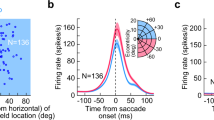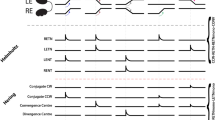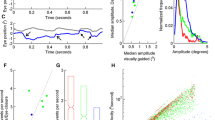Abstract
Saccade-related burst neurons were recorded in the caudal part of the fastigial nucleus (fastigial oculomotor region) during spontaneous eye movements and fast phases of optokinetic and vestibular nystagmus in light and darkness from three macaque monkeys. All neurons (n=47) were spontaneously active and exhibited a burst of activity with each saccade and fast phase of nystagmus. Most neurons (n=31) only exhibited a burst of activity, whereas those remaining also exhibited a pause in firing rate before or after the burst. Burst parameters varied considerably for similar saccades. For horizontal saccades all neurons, except for three, had a preferred direction with an earlier onset of burst activity to the contralateral side. For contralateral saccades the burst started on average 17.5 ms before saccade onset, whereas the average lead-time for ipsilateral saccades was only 6.5 ms. Three neurons were classified as isotropic with similar latencies and peak burst activity in all directions. None of the neurons had a preferred direction with an earlier onset of burst activity to the ipsilateral side. Burst duration increased with saccade amplitude, whereas peak burst activity was not correlated with amplitude. There was no relationship between peak burst activity and peak eye velocity. In the dark, neurons generally continued to burst with each saccade and fast phase of nystagmus. Burst for saccades in the dark was compared with burst for saccades of similar amplitude and direction in the light. Saccades in the dark had a longer duration and peak burst activity was reduced on average to 62% (range 36–105%). In three neurons a burst in the dark was no longer clearly distinguishable above the ongoing spontaneous activity. These data suggest that the saccade-related burst neurons in the FOR modify saccadic profiles by directly influencing acceleration and deceleration, respectively, of individual eye movements. This could be achieved by an input to the inhibitory and excitatory burst neurons of the saccadic burst generator in the brainstem. From neuroanatomical studies it is known that FOR neurons project directly to the brainstem regions containing the immediate premotor structures for saccade generation.
Similar content being viewed by others
References
Bahill AT, Brockenbrough A, Troost BT (1981) Variability and development of a normative data base for saccadic eye movements. Invest Ophthalmol 21:116–125
Bon L, Lucchetti C (1988) The motor programs of monkey's saccades: an attentional hypothesis. Exp Brain Res 71:199–207
Boyle R, Büttner U, Markert G (1985) Vestibular nuclei activity and eye movements in the alert monkey during sinusoidal optokinetic stimulation. Exp Brain Res 57:362–369
Büttner U, Büttner-Ennever JA (1988) Present concepts of oculomotor organization. In: Büttner-Ennever JA (ed) Neuroanatomy of the oculomotor system (Reviews of oculomotor research, vol 2) Elsevier, Amsterdam, pp 3–32
Büttner U, Fuchs AF, Markert-Schwab G, Buckmaster P (1991) Fastigial nucleus activity in the alert monkey during slow eye and head movements. J Neurophysiol 65:1360–1371
Crandall WF, Keller EL (1985) Visual and oculomotor signals in nucleus reticularis tegmenti pontis in alert monkey. J Neurophysiol 54:1326–1345
Eckmiller R, Petsch J (1975) A digital instantaneous impulse rate meter for neural activity. Electroencephalogr Clin Neurophysiol 39:414–416
Fuchs AF, Robinson FR, Straube A (1993) Role of the caudal fastigial nucleus in saccade generation. I. Neuronal discharge patterns J Neurophysiol 70:1723–1740
Hepp K, Henn V, Jaeger J (1982) Eye movement related neurons in the cerebellar nuclei of the alert monkey. Exp Brain Res 45:253–261
Ito M (1984) The cerebellum and neural control. Raven, New York
Judge SJ, Richmond BJ, Chu FC (1980) Implantation of magnetic search coils for measurement of eye position: an improved method. Vision Res 20:535–538
Kase M, Miller DC, Noda H (1980) Discharges of Purkinje cells and mossy fibres in the cerebellar vermis of the monkey during saccadic eye movements and fixation. J Physiol (Lond) 300:539–555
King WM, Lisberger SG, Fuchs AF (1986) Oblique saccadic eye movements of Primates. J Neurophysiol 56:769–784
Kurzan R, Straube A, Büttner U (1993) The effect of Muscimol microinjections into the fastigial nucleus on the optokinetic response and the vestibulo-ocular reflex in the alert monkey. Exp Brain Res 94:252–260
Leigh RJ, Zee DS (1991) The neurology of eye movements, 2nd ed. (Contemporary neurology series, vol 35). Davis, Philadelphia
Noda H, Fujikado T (1987) Involvement of Purkinje cells in evoking saccadic eye movements by microstimulation of the posterior cerebellar vermis of monkeys. J Neurophysiol 57:1247–1261
Noda H, Murakami S, Yamada J, Tamaki Y, Aso T (1988) Saccadic eye movements evoked by microstimulation of the fastigial nucleus of macaque monkeys. J Neurophysiol 60:1036–1052
Noda H, Sugita S, Ikeda Y (1990) Afferent and efferent connections of the oculomotor region of the fastigial nucleus in the Macaque monkey. J Comp Neurol 302:330–348
Ohtsuka K, Noda H (1991) Saccadic burst neurons in the oculomotor region of the fastigial nucleus of Macaque monkeys. J Neurophysiol 65:1422–1434
Ohtsuka K, Noda H (1992) Burst discharges of fastigial neurons in macaque monkeys are driven by vision- and memory-guided saccades but not by spontaneous saccades. Neuroscience Res 15:224–228
Optican LM, Robinson DA (1980) Cerebellar-dependent adaptive control of the primate saccadic system. J Neurophysiol 44:1058–1075
Robinson DA (1981) Control of eye movements. In: Brooks VB (ed) (Handbook of physiology, sect 1, The nervous system, vol II, part 2) American Physiological Society, Bethesda, Md., 1275–1320
Robinson FR, Straube A, Fuchs AF (1993) Role of the caudal fastigial nucleus in saccade generation. II. Effects of muscimol inactivation J Neurophysiol 70:1741–1758
Sato H, Noda H (1992) Saccadic dysmetria induced by transient functional decortication of the cerebellar vermis. Exp Brain Res 88:455–458
Yamada J, Noda H (1987) Afferent and efferent connections of the oculomotor cerebellar vermis in the macaque monkey. J Comp Neurol 265:224–241
Author information
Authors and Affiliations
Rights and permissions
About this article
Cite this article
Helmchen, C., Straube, A. & Büttner, U. Saccade-related activity in the fastigial oculomotor region of the macaque monkey during spontaneous eye movements in light and darkness. Exp Brain Res 98, 474–482 (1994). https://doi.org/10.1007/BF00233984
Received:
Accepted:
Issue Date:
DOI: https://doi.org/10.1007/BF00233984




